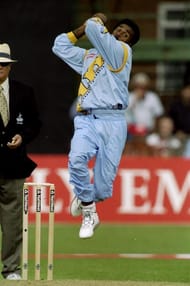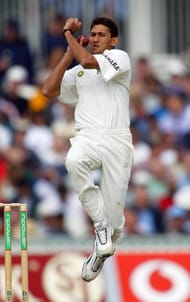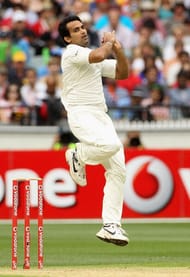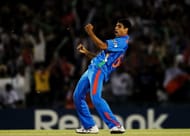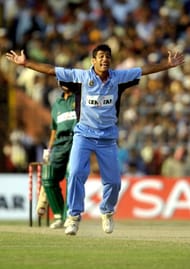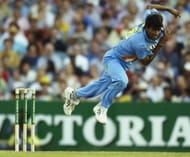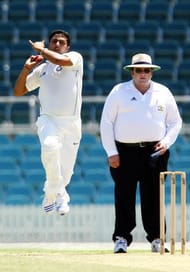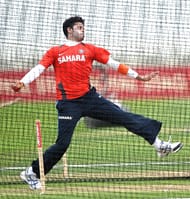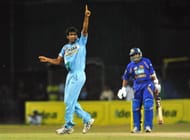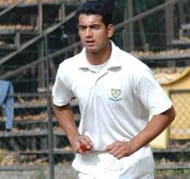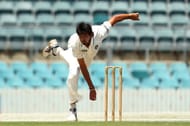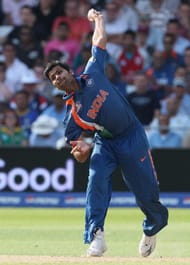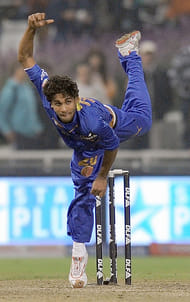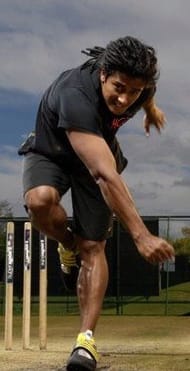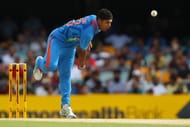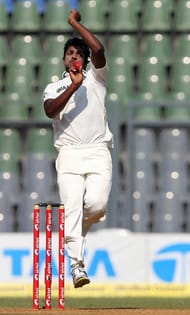Over the years, India has produced a number of wristy elegant batsmen and bamboozling world-class spinners. What they have, however, failed to produce even in moderate quantities is a tearaway quick. There has been the occasional speed merchant but, more often than not, he has tended to sell out his wares at a very early pace and settle for line and length on the unrewarding Indian featherbeds.
Which is why Mohammed Shami’s performance in Ranchi was heartening. Without compromising on lateral movement, he bowled consistently at over 140 kmph – which is a heartening sight for an Indian fast bowler. It may be a tad too early in the day but he has already been hailed as the next quickest thing this side of the Himalayas. In any case we are used to clutching straws in this department – we can only hope that his body allows him to maintain his pace (and swing) for the years to come. In the meanwhile we take a look at some of the other Indian bowlers who have touched 140 plus sometime or the other over the years.
Mohammed Nissar
Long before the speed guns came into force, there was Mohammed Nissar. A bull of a man, Nissar is probably the fastest bowler India has ever produced if not the fastest in the world. Those who had faced him conceded that he was faster than Harold Larwood – no mean feat considering the fact that Larwood was considered the fastest bowler of his time. In any case, over 50% of his victims were bowled or LBW – a statistical testimony to his pace. It’s good and bad that Nissar played in the thirties – bad because he could get to play only 6 Tests and good because if he had been born twenty years later he would have been playing for Pakistan.
For the next express bowler, India had to wait for over 50 years. While its neighbours rolled out an assembly line of some of the craftiest fast bowlers of the world, India stayed content with an embarrassment of spinning riches and the stock option of the swinger like Kapil Dev and his likenesses – Madan Lal, Roger Binny and Chetan Sharma. Which was ironical as, barring Binny, most of these bowlers came from the northern part of India and shared a common lifestyle with their Pakistani counterparts except for one thing – they did not consume beef and consumed little of other red meat which was touted to be the reason for building muscles which enabled one to bowl fast.
Javagal Srinath
It took a dosa-idli munching South Indian to disprove the theory. On his day, Javagal Srinath was as fast as anybody else and sometimes even faster. On his first two tours to South Africa, players from both sides acknowledged that he had bowled faster than Donald at times. Srinath clocked 90 mph quite regularly and till date remains the only (recorded) Indian fast bowler to cross 95 mph – against South Africa in ’96-’97.
Ajit Agarkar
It was not until Sourav Ganguly became captain that India again started to realize the fact that overseas victories were linked to having bowlers who could exploit the conditions. His first choice was a man who could astound and exasperate with equal efficiency – Ajit Agarkar. Agarkar, like his idol Ramakant Desai, had always been nippy – around the 140 kmph mark – since his debut but his recall to the side for the 2001-02 season provided some extra fuel for him to breach the 145 kmph mark. The zenith for his career would be the Australia tour a year later where he bowled with fire and brimstone to deliver India a victory in the historic Adelaide Test match.
A little later, India’s new speedsters were picking up pace. Zaheer Khan had touched 90 mph on his debut in the ICC Champions Trophy in 2000 but his career remained a work in progress till the New Zealand tour of 2002-03. Apart from his conventional and reverse swing, he had also added a yard or two of pace which would be a crucial thing to India’s campaign in the World Cup which was to follow.
Ashish Nehra
Even more surprising was the rise of Ashish Nehra as a genuine fast bowler. From his debut onwards, Nehra promised everything but pace. All that changed during the World Cup campaign where Nehra clocked 90 mph consistently and almost touched 150 kmph on an occasion. Among those who had expected this the least were the members of the English side who were blown away by his pace and swing on a balmy March evening in Durban.
Amit Bhandari
After an unsavoury debut in the 2000 Asia Cup against Pakistan, Amit Bhandari got a second chance in the 2004 tri-series involving India, Australia and Zimbabwe. With Agarkar and Irfan Pathan being the in-form bowlers, Bhandari got few opportunities to shine and he managed to get the speed guns going by touching 145 kmph. This was mighty surprising as on the domestic circuit he had hardly ever crossed 135 kmph. His performances were rewarded with a place in the squad for the Pakistan tour where he did not get a chance to play a game and soon faded into oblivion.
Lakshmipathy Balaji
On the same tour, another Indian fast bowler was undergoing a metamorphosis. It may be surprising but at the time of his debut in 2002 Lakshmipathy Balaji, along with NC Aiyappa, was considered amongst the fastest bowlers in South India. While the maximum the latter could do was to win a fast bowling contest, Balaji went on to play for India and get butchered by Chris Gayle for three extremely expensive overs. He returned a changed man a year later and his high came on the Pakistan tour of 2004 where, apart from tonking Shoaib Akhtar for a six over his head, he also managed to run up speeds of 143 kmph. Although nobody can trust the veracity of a birth certificate or a speed gun in Pakistan (in the same series, Mohammed Sami was found to have clocked 98 mph), Balaji is deceptive and has touched 140 kmph even in the IPL when no one has expected him to.
This period was followed by a brief lull in Indian cricket as it struggled to adjust to life with Greg Chappell in command and post Sourav Ganguly as captain. Chappell’s directive was simple – the workmanlike fast bowlers teeming the domestic circuits could continue to bowl their hearts out there; he wanted real fast bowlers.
Vikram Rajveer Singh
On the top of his most wanted list was a man with the face of a child and body of a steam engine – Vikram Rajveer Singh. After a couple of ODI matches, Chappell was clear what he wanted VRV to do – play Test cricket. He bowled fast without incision in the 5 Tests he played spread over a year. Another year later, his refusal to compromise on speed meant that his first class career was effectively over.
Sreesanth
The second on this list was a man who could (can) do anything only if he wants to. When he started out, Shanthakumaran Sreesanth had everything a fast bowler needs – a stable wrist position, a terrific bouncer, and the ability to swing the ball both ways and a generous amount of speed. Throughout his career, Sreesanth was clocked in the higher 130s; in the early part of his career, he had also managed to touch 149 kmph in a tri-series in Malaysia. All of that talent was laid to waste though by his propensity to self-destruct.
Munaf Patel
The last in Chappell’s Top 3 is probably Indian cricket’s greatest rags-to-riches story – Munaf Patel. In 2003, Kiran More had spotted him while he was bowling in the nets and by the end of the years Patel was an India A bowler even before he had made his first-class debut. After roughing up the visiting New Zealanders on debut, he accepted a contract with Mumbai after a word with Sachin Tendulkar. A couple of seasons later, it seemed as if he had arrived when he took 7 for 97 to bowl India to victory over England in his first Test – the best performance ever by an Indian fast bowler on debut. The speed though was to go down and, last heard of, the best job option he has is as a back-up bowler for Mumbai Indians. From rags to riches to riches in the form of rags – such is Munaf Patel’s story.
Abid Nabi
What followed these three is a largely untold story – that of Abid Nabi. Before Parvez Rasool, Nabi was seen as the next big hope from the state of Jammu & Kashmir. Dennis Lillee had spotted him at the MRF pace academy and alerted Chappell which meant that Nabi was now bowling in the India nets. Like VRV, Nabi was an out and out quick – a commodity always high in demand. The only thing he did wrong was to play for a team which is arguably the weakest in Indian domestic cricket. His team’s failures weighed heavy of Nabi and, disillusioned, he joined the rebel Indian Cricket League effectively closing the hatch on his spot in the sun.
Ishant Sharma
After the Chappell era and India’s disastrous World Cup 2007 campaign, India somehow managed to find the most extreme of rarities – a tall fast bowler. The only thing common then and now for Ishant Sharma was his Goldilocks hair – back in 2008, he was Indian cricket’s greatest discovery as he terrorized the likes of Ponting and company with his pace and bounce as India won a Test match on a ground they would have never expected to – Perth. Ishant remains the only Indian bowler after Srinath to have recorded 150 kmph – it happened on that glorious tour. Since then, his pace (and now his form) has been on a downward spiral although he has touched speeds close to 150 kmph a couple of times in the IPL.
Rudra Pratap Singh
In that same Test match at Perth, another unexpected entity breached the 145 kmph barrier. For the greater part of his career, Rudra Pratap Singh found himself playing understudy to Zaheer Khan or Irfan Pathan but, on this one occasion, RP matched Pathan for swing and Ishant for pace. In the Greg Chappell era, he was seen as someone who would keep the fort gates closed while the likes of VRV and Sreesanth went out to battle but, over the years, he came into his own with some fine performances in helpful conditions. He failed to ride the crest though and soon fell behind in the reckoning.
Kamran Khan
The early IPL years were eventful in seeking and destroying Indian talent. An exception to this rule was the Rajasthan Royals franchise which used its position to leverage players who otherwise might not have received an opportunity to play at that level. In 2009 to take advantage of the South African conditions, they selected the duo of Kamran Khan and Atul Sharma to beef up their fast bowling resources. Kamran was Munaf Patel redux – a woodcutter’s son, he had no prior experience of playing the game and had been handed a contract solely on Shane Warne’s gut feeling. A few insipid IPL seasons later, he made his first club debut this year for the Sri Lankan domestic team Colts Cricket Club.
Atul Sharma
Atul Sharma’s story is even more interesting. He was reported to be consistently bowling over 160 kmph or 100 mph in the nets. He had apparently trained with the US javelin Olympians and also with England bowling coach Ian Pont. A Youtube video of him chopping trees, running with truck tyres around his neck and doing bench presses went viral. It has been five years since then and he remains as much of an enigma as in 2009.
The hunt stopped for a couple of years as India focussed on its 2011 World Cup campaign. A successful outing later, they went to England with an unfit Zaheer Khan and a bunch of medium fast bowlers. At the fag end of the Test series, they had resorted to calling an out-of-shape RP Singh to wear the India whites. After the 4-0 drubbing, one message came out strong and clear – we needed better fast bowlers.
Umesh Yadav
Enter Umesh Yadav and Varun Aaron. Both had a lot in common – they came from unheralded places, played in one of the weaker teams of the Ranji trophy (Yadav for Vidharba and Aaron for Jharkhand), did not want to give up on pace and were highly injury promise. Both started off with a bang before ending up injured but Yadav has somehow managed to intersperse a couple of fine performances – he was one of the sole bright spots for India in Australia the last time around.
Varun Aaron
In contrast, Aaron has suffered a complete meltdown – since his debut, he is yet to last a full Ranji season. One hopes though that he gets back to his feet soon given the promise he holds in a cupboard which is mostly bare.
As of now there are a few other options going around. When he bends his back, Ashok Dinda can crank up 140 kmph without too much of effort – the only problem is that he is too erratic. The same can be said of Parvinder Awana – in any case, he is a couple of yards quicker too. In my opinion, he remains a decent back-up option as of date. In the recent past, Rahul Shukla has proved to be nippy in supportive conditions.
As in the past, it has never been that India is well and truly short of a genuine quick. It is just that we are yet to find someone who can sustain the pace and energy for a significant period of time. Here’s to hoping that Shami or Yadav or, for that matter, anyone else fills the gap in the years to come.
Brand-new app in a brand-new avatar! Download CricRocket for fast cricket scores, rocket flicks, super notifications and much more! 🚀☄️
